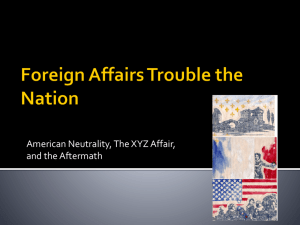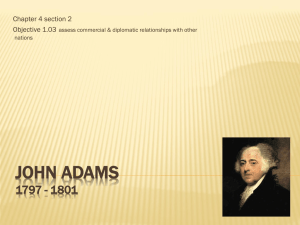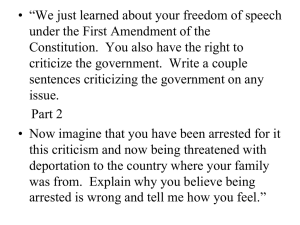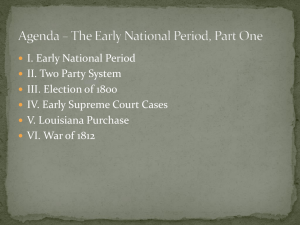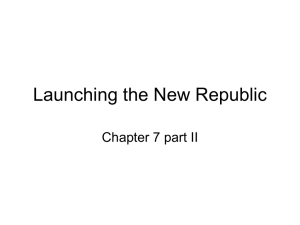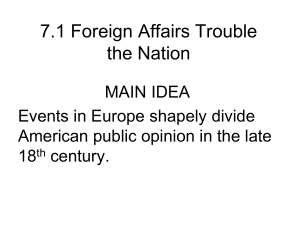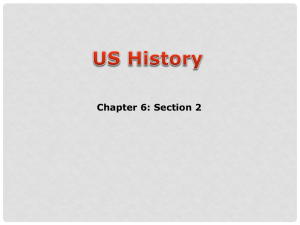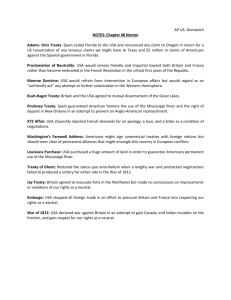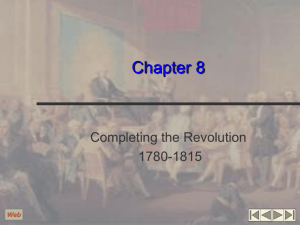Foreign Affairs Trouble the Nation
advertisement
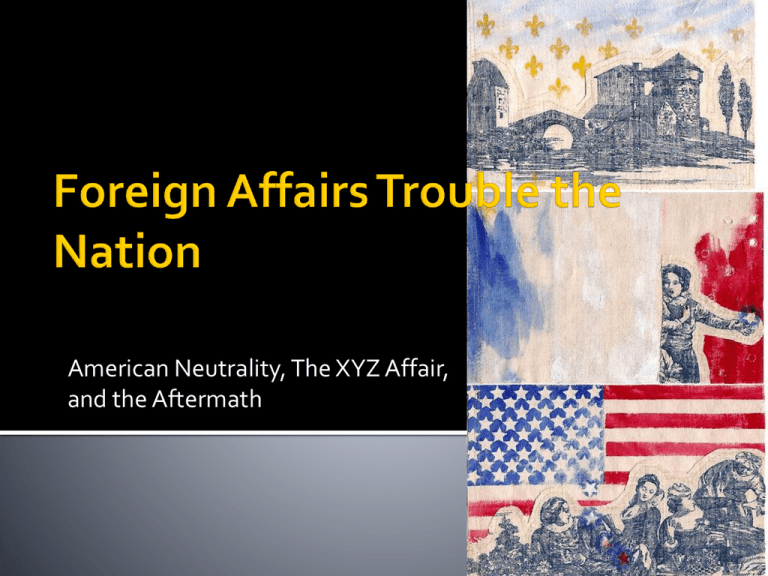
American Neutrality, The XYZ Affair, and the Aftermath July 14th, 1789, a mob stormed the Bastille and thus began the French Revolution. Word of these events quickly spread to America, and the U.S. government knew that they would become involved… but how? Most people supported the revolution since it mirrored the American struggle. Politically, the U.S. also had an alliance with France through the Treaty of 1778. As time passed, Americans took sides for or against supporting the revolution in France. The Reign of Terror that began with the rise of the Jacobins made choosing a side more complex. This topic became split along party lines with the Democratic-Republicans backing the French and the Federalists backing Britain. The French expected U.S. support due to their alliance, but Washington faced the issue of having faction within his cabinet. He chose the middle ground… neutrality. The U.S. would support neither side in the European conflict since the new nation could not risk such a war. In this same month, the French had sent a diplomat named Edmond Genet to win American support. What did Genet do that caused Washington to order Franc e to recall him? Genet acted as a recruiter rather then a diplomat. He attempted to recruit citizens to fight in the Revolution, instead of showing his credentials to the administration and discussing possible aid. These issues with France ultimately led to Jefferson’s resignation from the cabinet in 1793 due to his issues with Hamilton and Federalists calling him a radical since he supported France. The U.S. also wanted to secure land claims west of the Appalachians and gain shipping rights on the Mississippi River, and to do so they had to deal with Spain. At the same time, Spain owned the Louisiana Territory and Florida, which made them still very powerful in North America. Negotiations stalled due to issues in Europe. Spain had signed a treaty with France to secure peace, yet they feared the U.S. would attack them with Britain. This fear drove Spain to meeting with Thomas Pinckney, the U.S. minister to Britain, in Oct.27th 1795. A treaty was drafted that conceded all that the U.S. wanted. All land east of the Mississippi, rights to ship on the river, and boundaries. When pioneers began moving west after the issues with Spain had been resolved, they treated the land as if they had a rightful claim to it. They forgot that it had native inhabitants, but the natives did not go down easy. British troops remained in the Northwest territories, and many encouraged the natives there to continue their resistance. Many settlers were attacked by natives in the Ohio River Valley. This tribal group was known as the Miami Confederacy, and was led by Chief Little Turtle. Little Turtle led his tribe to several victories against the federal army until Washington changed his leadership of the army and they delivered a crushing blow at the Battle of Fallen Timbers The victory at Fallen Timbers ended Native American resistance in Ohio and led to the Miami Confederacy signing the Treaty of Greenville which gave them $20,000 in goods and an annual payment of $10,000. This was not nearly enough money for the amount of land. At the same time, the U.S. needed to deal with the British presence in Ohio. John Jay, the chief justice, was in London to negotiate a treaty with Britain. When news of the victory at the Battle of Fallen Timbers reached London, the British quickly decided to evacuate forts. Although the treaty passed Senate, many were angered by the terms that included allowing British to continue their fur trade on the American side of the U.S.Canadian border. By 1797, the issues over Jay’s Treaty and the growing rift between the Federalists and Democratic-Republicans led Washington to retire to Mount Vernon. The election of 1796 led to some major issues when John Adams, the Federalist candidate, and Thomas Jefferson, the Democratic-Republican candidate, became President & Vice-President due to issues within the Constitution. The Constitution did not account for political factions and therefore it stated that the runner-up of a presidential election would be the vice-president. This election also showed the early dangers of sectionalism- placing the interests of a region over those of a nation- seeing as the North voted for Adams and the South voted for Jefferson. The first crisis Adams faced as the new president was the looming war with France. France viewed the treaty between the U.S. and Britain a violation of their treaty with the U.S. They began seizing U.S. ships bound for Britain and refused to accept an American Ambassador. Adams sent a three-man delegation consisting of Charles Pinckney, Elbridge Gerry, and John Marshall to meet with the French foreign minister Talleyrand. The French Directory instead sent 3 low-level officials, later called “X,Y and Z,” to meet the delegates. They demanded a $250,000 bribe to see Talleyrand. This event became known as the X,Y,Z Affair, and led to a wave of anti-French sentiments throughout the U.S. The Congress created a navy department in 1798 and authorized American ships to seize French vessels. This led to a naval war raging for the next 2yrs. between France and the U.S. Congress pushed a four measure act through in 1798 to counter the “threat” against the government. This became known as the Alien and Sedition Acts. The Alien Acts: raised residence requirements from 5 to 14yrs for citizenship and allowed the president to deport or jail any alien considered undesirable. The Sedition Act: set fines and jail terms to anyone trying to undermine the government. This led to several Democratic-Republicans being jailed as well as outrage. Anti-French feelings led to many Federalists becoming paranoid that French agents were everywhere, especially since foreign-born immigrants were active in the Democratic-Republican party. James Madison and Thomas Jefferson saw the Alien and Sedition Acts as a serious misuse of power by the federal government. They organized opposition to the acts by appealing to the states. They wrote resolutions to Kentucky and Virginia in which the principles of nullification were asserted. This implied that states had the right to consider void any act they deemed unconstitutional. Virginia & Kentucky also claimed the right to declare null and void federal laws going beyond powers granted by the Constitution to the federal government. These resolutions showed the balance between federal and state powers was still controversial. On December 14th, 1799, George Washington died after catching a severe cold. The nation mourned his loss, especially since he was still active and instrumental in helping the new government, even while in retirement at Mount Vernon. Napoleon, hoping to earn American support, ordered for 10 days of mourning to be observed in the French armies for Washington. This French support would be even greater in the coming years when Napoleon would offer us one of the largest pieces of land in North America… the Louisiana Purchase. HW: SPNotes 6.3 Make-up work should be making its way in as the term is coming to an end. Leave the room better than you found it, and have a great day!
